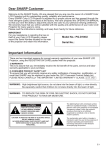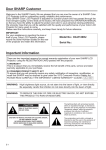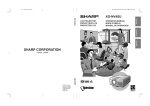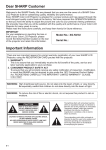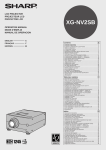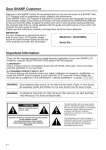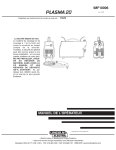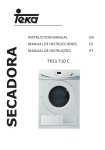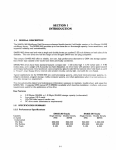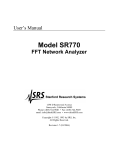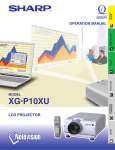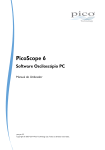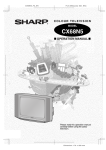Download Sharp XG-E690UB Operation Instruction manual
Transcript
XG-E690UB (E)/pp. 01-04 G. K . A s s o c i a t e s , To k y o 1998/5/21 Dear SHARP Customer Welcome to the SHARP Family. We are pleased that you are now the owner of a SHARP Color LCD Projector built for outstanding quality, reliability and performance. Every SHARP Color LCD Projector is adjusted for a proper picture and has passed through the most stringent quality control tests at the factory. We have prepared this OPERATION MANUAL so that you have the ability to adjust the picture and color to your personal viewing preference. We sincerely hope that you will be satisfied with the quality and performance of your Color LCD Projector for many years to come. Please read the instructions carefully, and keep them handy for future reference. IMPORTANT For your assistance in reporting the loss or theft of your Color LCD Projector, please record the Serial Number located on the rear of the projector and retain this information. Model No.: XG-E690UB Serial No.: Important Information There are two important reasons for prompt warranty registration of your new SHARP LCD Projector, using the REGISTRATION CARD packed with the projector. 1) WARRANTY This is to assure that you immediately receive the full benefit of the parts, service and labor warranty applicable to your purchase. 2) CONSUMER PRODUCT SAFETY ACT To ensure that you will promptly receive any safety notification of inspection, modification, or recall that SHARP may be required to give under the 1972 Consumer Product Safety Act, PLEASE READ CAREFULLY THE IMPORTANT “LIMITED WARRANTY” CLAUSE. U.S.A. ONLY WARNING: High brightness light source, do not stare into the beam of light, or view directly. Be especially careful that children do not stare directly into the beam of light. WARNING: TO REDUCE THE RISK OF FIRE OR ELECTRIC SHOCK, DO NOT EXPOSE THIS PRODUCT TO RAIN OR MOISTURE. CAUTION RISK OF ELECTRIC SHOCK. DO NOT REMOVE SCREWS EXCEPT SPECIFIED USER SERVICE SCREW. CAUTION: TO REDUCE THE RISK OF ELECTRIC SHOCK, DO NOT REMOVE COVER. NO USER-SERVICEABLE PARTS EXCEPT LAMP UNIT. REFER SERVICING TO QUALIFIED SERVICE PERSONNEL. E-1 The lightning flash with arrowhead symbol, within an equilateral triangle, is intended to alert the user to the presence of uninsulated “dangerous voltage” within the product’s enclosure that may be of sufficient magnitude to constitute a risk of electric shock to persons. The exclamation point within a triangle is intended to alert the user to the presence of important operating and maintenance (servicing) instructions in the literature accompanying the product. XG-E690UB (E)/pp. 01-04 1998/5/21 G. K . A s s o c i a t e s , To k y o WARNING: FCC Regulations state that any unauthorized changes or modifications to this equipment not expressly approved by the manufacturer could void the user’s authority to operate this equipment. U.S.A. ONLY INFORMATION This equipment has been tested and found to comply with the limits for a Class A digital device, pursuant to Part 15 of the FCC Rules. These limits are designed to provide reasonable protection against harmful interference when the equipment is operated in a commercial environment. This equipment generates, uses, and can radiate radio frequency energy and, if not installed and used in accordance with the instruction manual, may cause harmful interference to radio communications. Operation of this equipment in a residential area is likely to cause harmful interference, in which case the user will be required to correct the interference at his own expense. U.S.A. ONLY The enclosed VGA signal cable and Mac/VGA adaptor must be used with the device. The cable and adaptor are provided to ensure that the device complies with FCC Class A verification. U.S.A. ONLY Important Safeguards Electrical energy can perform many useful functions. This unit has been engineered and manufactured to ensure your personal safety. But IMPROPER USE CAN RESULT IN POTENTIAL ELECTRICAL SHOCK OR FIRE HAZARD. In order not to defeat the safeguards incorporated into this LCD Projector, observe the following basic rules for its installation, use and servicing. For your own protection and reliable usage of your LCD Projector, please be sure to read these “Important Safeguards” carefully before use. 1) 2) 3) 4) 5) 6) 7) 8) 9) Read Instructions — All the safety and operating instructions should be read before the product is operated. Retain Instructions — The safety and operating instructions should be retained for future reference. Heed Warnings — All warnings on the product and in the operating instructions should be adhered to. Follow Instructions — All operating and use instructions should be followed. Cleaning — Unplug this product from the wall outlet before cleaning. Do not use liquid cleaners or aerosol cleaners. Use a damp cloth for cleaning. Attachments — Do not use attachments not recommended by the product manufacturer as they may cause hazards. Water and Moisture — Do not use this product near water — for example, near a bathtub, wash bowl, kitchen sink, or laundry tub; in a wet basement; or near a swimming pool; and the like. Accessories — Do not place this product on an unstable cart, stand, tripod, bracket, or table. The product may fall, causing serious injury to a child or adult, and serious damage to the product. Use only with a cart, stand, tripod, bracket, or table recommended by the manufacturer, or sold with the product. Any mounting of the product should follow the manufacturer’s instructions, and should use a mounting accessory recommended by the manufacturer. A product and cart combination should be moved with care. Quick stops, excessive force, and uneven surfaces may cause the product and cart combination to overturn. 10) Ventilation — Slots and openings in the cabinet are provided for ventilation to ensure reliable operation of the product and to protect it from overheating, and these openings must not be blocked or covered. The openings should never be blocked by placing the product on a bed, sofa, rug, or other similar surface. This product should not be placed in a built-in installation such as a bookcase or rack unless proper ventilation is provided or the manufacturer’s instructions have been adhered to. 11) Power Sources — This product should be operated only from the type of power source indicated on the marking label. If you are not sure of the type of power supply to your home, consult your product dealer or local power company. For products intended to operate from battery power, or other sources, refer to the operating instructions. 12) Grounding or Polarization — This product is equipped with a three-wire grounding-type plug, a plug having a third (grounding) pin. This plug will only fit into a grounding-type power outlet. This is a safety feature. If you are unable to insert the plug into the outlet, contact your electrician to replace your obsolete outlet. Do not defeat the safety purpose of the grounding-type plug. 13) Power-Cord Protection — Power-supply cords should be routed so that they are not likely to be walked on or pinched by items placed upon or against them, paying particular attention to cords at plugs, convenience receptacles, and the point where they exit from the product. 14) Lightning — For added protection for this product during a lightning storm, or when it is left unattended and unused for long periods of time, unplug it from the wall outlet and disconnect the cable system. This will prevent damage to the product due to lightning and power-line surges. E-2 XG-E690UB (E)/pp. 01-04 1998/5/21 G. K . A s s o c i a t e s , To k y o 15) Overloading — Do not overload wall outlets, extension cords, or integral convenience receptacles as this can result in a risk of fire or electric shock. 16) Object and Liquid Entry — Never push objects of any kind into this product through openings as they may touch dangerous voltage points or short-out parts that could result in a fire or electric shock. Never spill liquid of any kind on the product. 17) Servicing — Do not attempt to service this product yourself as opening or removing covers may expose you to dangerous voltage or other hazards. Refer all servicing to qualified service personnel. 18) Damage Requiring Service — Unplug this product from the wall outlet and refer servicing to qualified service personnel under the following conditions: a) b) c) d) e) f) When the power-supply cord or plug is damaged. If liquid has been spilled, or objects have fallen into the product. If the product has been exposed to rain or water. If the product does not operate normally by following the operating instructions. Adjust only those controls that are covered by the operating instructions, as an improper adjustment of other controls may result in damage and will often require extensive work by a qualified technician to restore the product to normal operation. If the product has been dropped or damaged in any way. When the product exhibits a distinct change in performance — this indicates a need for service. 19) Replacement Parts — When replacement parts are required, be sure the service technician has used replacement parts specified by the manufacturer or with the same characteristics as the original part. Unauthorized substitutions may result in fire, electric shock, or other hazards. 20) Safety Check — Upon completion of any service or repairs to this product, ask the service technician to perform safety checks to determine that the product is in proper operating condition. 21) Heat — The product should be situated away from heat sources such as radiators, heat registers, stoves, or other products (including amplifiers) that produce heat. About the Temperature Monitor Function: TEMP. • If the projector starts to overheat due to set-up problems or a dirty air filter, “TEMP.” will flash in the upper-left corner of the picture. If the temperature continues to rise, then the lamp will turn off, the TEMPERATURE WARNING indicator will flash, and after a 90-second cooling-off period the power will shut off. Refer to page 24, “Maintenance Indicators”, when the “TEMP.” warning appears in the picture. Outstanding Features Allows easy projection of large screen, full-color computer and video images. • Can be projected directly onto a video screen or white wall. • Lightweight, convergence-free system for easy installation. DIRECT COMPUTER COMPATIBILITY A multi-scan RGB Input accepts signals from SVGA (800 dots 2 600 lines), VGA and Mac (832 dots 2 624 lines compressed/640 dots 2 480 lines maximum) compatible computers without the need for any additional hardware. KEYSTONE FUNCTION Actively corrects keystone distortions to provide a square picture with a correction in screen size. HIGH PICTURE QUALITY A single LCD panel contains 480,000 2 RGB pixels to achieve exceptionally bright, high quality video images with up to 580 line doubled TV lines of resolution. FLEXIBLE USE • In addition to the standard front projection mode, the menu driven functions can be used to instantly reverse the image (for rear projection). • Screen projection size adjusts from 40 to 150 inches. BUILT-IN STEREO SPEAKERS Built-in 5 W`5 W amplifiers and stereo speakers eliminate the need for external audio components. E-3 XG-E690UB (E)/pp. 01-04 1998/5/21 G. K . A s s o c i a t e s , To k y o Location of Controls Remote control signal receiver window FRONT VIEW Focusing ring Cooling fan (exhaust vent) Carrying handle OPERATION PANEL ON SIDE OF PROJECTOR INPUT SELECT button BLACK SCREEN button MENU button POWER ON/OFF button E-ZOOM/PANNING button ADJUSTMENT (ƒ/∂) buttons POWER indicator LAMP REPLACEMENT indicator TEMPERATURE WARNING indicator VOLUME UP-DOWN buttons ADJUSTMENT (ß / ©) buttons MUTE button REAR VIEW Speaker Cooling fan (intake vent) Air filter KEYSTONE/SIZE CORRECTION knob MAIN POWER button COMPUTER AUDIO INPUT (Stereo mini jack) INPUT OUTPUT COMPUTER RGB COMPUTER RGB INPUT connector (HD-15) FILTER OFF ON S-VIDEO INPUT VIDEO INPUT (4-pin mini DIN) Video: RCA Audio: RCA FILTER ON/OFF switch COMPUTER RGB OUTPUT connector (HD-15) R L VIDEO OUTPUT Video: RCA Audio: RCA COMPUTER R L IN OUT S-VIDEO VIDEO AUDIO VIDEO AUDIO E-4 XG-E690UB (E)/pp. 05-08 1998/5/21 G. K . A s s o c i a t e s , To k y o Remote Control Operation REMOTE CONTROL REMOTE CONTROL SIGNAL TRANSMITTER VOLUME UP-DOWN buttons ADJUSTMENT (ƒ/∂) buttons (Can be used as ADJUSTMENT (ƒ/∂) buttons when the MENU button is pressed.) ADJUSTMENT TRANSMIT TRANSMIT indicator VOL ON/OFF ADJUSTMENT (ß/©) buttons POWER (ON/OFF) button MUTE E-ZOOM/PANNING button E-Z MUTE button MENU MENU button LIGHT button IN LIGHT Using the remote control in a dark room Press the LIGHT button. • This will cause the operation buttons to stay lit for about 5 seconds. INPUT SELECT LCD PROJECTOR INPUT SELECT button Remote control handling precautions Do not expose the remote control to shocks, liquids or high humidity. The remote control may not operate normally if exposed to direct sunlight or other intense light sources. Should this happen, reposition the light source or the LCD Projector. Inserting the batteries Remove the battery cover as shown and insert two AAA size batteries making sure the polarity matches the (+) and (–) marks inside the battery compartment. Notes: Incorrect use of batteries may cause them to leak or burst. • Insert the batteries with the (+) and (–) polarities as indicated. • Remove the batteries if the remote control will not be operated for an extended period of time. • Maintain the batteries in clean condition. • Do not mix different brands of batteries. The life expectancy of the new batteries will be shortened and the old batteries may leak. • When the batteries have been used up, remove them immediately to prevent leakage and damage. Leaked battery fluid may irritate the skin. Remove any battery fluid by wiping with a cloth. • Due to storage conditions and the shelf life of the supplied batteries, they may run out after a short time. Replace them with new batteries as soon as possible. Press down Slide out Slide in Battery cover Transmission range 30° Reception range 30° Max. distance : 23' (7m) 30° E-5 45° Remote control positioning Use the remote control as shown in the figures on the left. Note: • The signal from the remote control can be reflected off the screen for easy operation. However, the effective distance of the signal may differ due to the screen material. XG-E690UB (E)/pp. 05-08 1998/5/21 G. K . A s s o c i a t e s , To k y o Setting Up the Projector Projector Distance and Picture Size Relationship • • This projector has a fixed-focus lens. Refer to the diagram below to determine the picture size and projection distance. The picture can be focused when the projector is within 4.3 ft to 14.4 ft of the screen. Please set up the projector within this range. Distance from screen Picture size: 100 inches (254 cm) Picture size (diag.) Projection distance (L) 150 inches 14.4 ft (4.4 m) 100 inches 9.8 ft (3.0 m) 80 inches 7.9 ft (2.4 m) 60 inches 6.2 ft (1.9 m) 40 inches 4.3 ft (1.3 m) Note: • An undistorted image can be achieved when the lens center and the lower edge of screen are aligned, shown to the left. Lens Center 90° Lower edge of screen (white portion) L: 9.8 ft (3.0 m) Distance between lens and screen: L • Above is an illustration of projection distance for the XG-E690UB with a picture size of 100 inches (254 cm). Height of projector • Picture size (diag.) Upper position Lower position 22 3/64 inches (56 cm) –8 17/64 inches (–21 cm) 100 inches 14 61/64 inches (38 cm) –5 29/32 inches (–15 cm) 80 inches 11 13/16 inches (30 cm) –4 23/32 inches (–12 cm) 60 inches 9 1/16 inches (23 cm) –3 5/32 inches (–8 cm) 40 inches 5 29/32 inches (15 cm) –2 23/64 inches (–6 cm) This projector is equipped with a Keystone adjustment function that lets you adjust the projection height without 150 inches moving the projector. Adjust to match the setup configuration. • Picture size: 100 inches (254 cm) Distance from lens center to lower edge of screen (H) Lens Center 90° Upper position H: 14 61/64 inches -H: –5 29/32 inches Lower position How to set up the projector and screen Max. 10˚ Caution: When setting up the projector • For minimal servicing and to maintain high image quality, SHARP recommends that this projector be installed in an area free from humidity, dust and cigarette smoke. When the projector is subjected to these environments, the lens and filter must be cleaned more often. Periodically the filter should be replaced and the projector should be cleaned internally. As long as the projector is properly maintained in this manner, use in these environments will not reduce the overall operation life. Please note that all internal cleaning must be performed by an Authorized Sharp Industrial LCD Products Dealer or Service Center. • Do not expose to extreme heat or cold. Operating temperature: 41°F to 104°F (5°C to 40°C) Storage temperature: -4°F to 132°F (-20°C to 60°C) • Do not tilt the projector more than 10°. • Position the screen so that it is not in direct sunlight or room light. Light falling directly onto the screen washes out colors, making viewing difficult. Close the curtains and dim the lights when using the screen in a bright or sunny room. • The best picture will be obtained when the projector is at a 90 degree angle to the screen. Position the projector and screen as shown. E-6 XG-E690UB (E)/pp. 05-08 1998/5/21 G. K . A s s o c i a t e s , To k y o Example of a standard setup TOP VIEW 90° The projector lens should be centered in the middle of the screen. SIDE VIEW Lens center 90° Lens center If the projector and screen are not centered properly, the picture will be distorted, making viewing difficult. Using the reverse function makes the following setups possible. Example of a reversed image setup • By placing a mirror (normal flat type) in front of the lens and using the reverse function, the image reflected from the mirror can be projected onto the screen. (See E-21.) • Rear projection with a rear projection screen is also possible when using the reverse function. AUDIENCE SIDE 90 ° The projector lens should be centered in the middle of the screen. Rear Projection 90° If the projector and screen are not centered properly, the picture will be distorted, making viewing difficult. Mirror Using the Focus, Keystone and Size Correction Functions • Focus, Keystone and Reversed Image mode functions broaden your options for projector placement. • See pages 6 and 7 for details on projector setup. 1. Turn ON the POWER. See page 14 for turning on the power. 2 2. Adjusting the Focus Rotate the focus ring until the top portion of the screen is in focus. 3 3. Controlling keystone effects This projector allows you to fix uneven screen images of up to approximately 10˚ due to projector or screen positioning. • Rotate the KEYSTONE/SIZE CORRECTION knob to the right or left to widen or shorten the bottom portion of the screen. 4 E-7 4. Correcting the picture size Move the KEYSTONE/SIZE CORRECTION knob. • Slide it to the left to enlarge the picture size or decrease the projection distance. • Slide it to the right to decrease the picture size or increase the projection distance. Notes: • This function allows you to correct the screen size up to approximately 10% after adjusting the Keystone effects. • After correcting the keystone effects and picture size, adjust the focus again. XG-E690UB (E)/pp. 05-08 1998/5/21 G. K . A s s o c i a t e s , To k y o Adjusting the Height of the Picture • Use the adjuster release to adjust the angle of the projector and height of the picture. Minor adjustments can be made with the adjusters. Adjusters Adjuster release 1 1. Press the adjuster release and lift the projector to the desired angle with both hands. • The adjuster legs will extend to the surface of the table. 2 2. Remove your hand from the adjuster release. • The adjuster legs will lock in position. Release the projector once you are sure the adjuster legs have locked in position. 3 3. Make any minor adjustments necessary. • Turn the adjusters to further adjust the angle of the projector. Returning the projector to its original position • While holding the projector with both hands, press the adjuster release and slowly lower the projector to its original position. Notes: • When adjustments are made with the adjusters, the picture may become distorted, depending on the relative positions of the projector and the screen. • After adjusting, in some cases, all of the adjusters’ feet may not be resting on the mounting surface. To prevent the projector from wobbling, adjust the adjusters’ feet so that they firmly contact the mounting surface. Cautions: • Do not press the adjuster release when the adjuster legs are extended without firmly holding the projector. • When lowering the projector, be careful not to get your fingers caught in the area between the adjusters and the projector. • Do not hold the lens when lifting or lowering the projector. Transporting the Projector Use the carrying handle when moving the projector. When transporting the projector, carry it by the handle located on the side of the unit. Note: When transporting the projector, always put on the lens cap to prevent damage to the lens. Caution: Do not lift or carry the projector by the lens. E-8 XG-E690UB (E)/pp. 09-10 1998/5/21 G. K . A s s o c i a t e s , To k y o Connecting the Projector Rear terminals To watch video playback with the projector connected to audio/video output equipment, such as a VCR or Laser Disc Player, or to view on a separate monitor: Used when the AV equipment to be connected has an S-VIDEO output terminal. R L COMPUTER R • Always turn off the LCD Projector while connecting to video equipment, in order to protect both the projector and the equipment being connected. L IN OUT S-VIDEO VIDEO Playback To S-video output terminal To video output terminal AUDIO VIDEO To video input terminal To audio output terminals VCR AUDIO To audio input terminals Note the following when using the S-VIDEO INPUT terminal: • The S-VIDEO INPUT terminal uses a video signal system in which the picture is separated into a color and a luminance signal to realize a higher-quality picture. • The S-VIDEO INPUT terminal has priority over the VIDEO INPUT terminal. Make the audio connection via the VIDEO INPUT audio terminals (left/right). • The S-VIDEO INPUT terminal is used when the AV equipment to be connected has an S-VIDEO output terminal. • S-VIDEO cannot be output from the VIDEO OUTPUT terminal. If a connection is made to both the S-VIDEO INPUT terminal and the VIDEO INPUT terminal, the signal input from the VIDEO INPUT terminal will be output from the VIDEO OUTPUT terminal and the projector will display the S-VIDEO image because the S-VIDEO INPUT terminal has priority. Note: • By using the external amplifier, the volume can be amplified for greater sound. E-9 XG-E690UB (E)/pp. 09-10 1998/5/21 G. K . A s s o c i a t e s , To k y o Connecting the Projector (RGB: Computer) 1 Rear view of the projector INPUT OUTPUT COMPUTER RGB IBM-PC (VGA, SVGA) Series (computer) FILTER OFF ON RGB Signal Input Socket VGA Signal Cable (Supplied) ANALOG RGB OUT RGB Signal Output Socket You can connect your projector to a computer for easy projection of full-color computer images, or an external monitor for simultaneous viewing. Before connecting, be sure to turn both the projector and the computer off. After making all connections, turn the projector on first. The computer should always be turned on last. 1. Connecting to an IBM-PC (VGA, SVGA) Series computer—800 x 600 maximum resolution Plug the VGA signal cable correctly into the RGB INPUT terminal on the projector and into the RGB signal output terminal on the computer, and secure the plugs by tightening the thumb screws. Note: • This connection is possible only when using a computer with a VGA/SVGA or Mac display output port. T B OG RG OU AL AN Mac/VGA Adaptor (Supplied) 2Q T Macintosh B OG RG OU AL 2. Connecting to a Macintosh Series Computer • 640 x 480 resolution AN Q First, connect the supplied Mac/VGA adaptor to the RGB signal output terminal on your Macintosh Series computer, as shown on the left, and secure the plugs. RGB Signal Output Socket W W Next, firmly plug the supplied VGA signal cable into both the RGB input terminal on the projector and the Mac/VGA adaptor on the computer, and secure the plugs by tightening the thumb screws. Rear view of the projector RGB Signal Input Socket • 832 x 624 resolution Macintosh RGB Signal Output Socket When connecting in the 832 x 624 dot mode, use a Mac/VGA adaptor with display mode switching function available from your local computer dealer. ANALOG RGB OUT VGA Signal Cable (Supplied) E-10 XG-E690UB (E)/pp. 11-12 1998/5/21 G. K . A s s o c i a t e s , To k y o 3. Connecting to other compatible computers When connecting the projector to a compatible computer other than an IBM-PC (VGA/SVGA) or Macintosh series, a separate cable is needed. Please contact your dealer for ordering information. Notes: • Connection to computers other than the recommended types may result in damage to the projector, the computer, or both. • Connect the audio from the computer to the COMPUTER AUDIO INPUT terminal. 4 INPUT 4. External monitor connection FILTER OFF ON OUTPUT COMPUTER RGB Optional third source VGA/Mac adaptor cable Direct connection U.S.A. ONLY or External IBM-PC monitor External Macintosh monitor Connect your computer monitor to the projector’s COMPUTER RGB OUTPUT terminal to view images simultaneously on the external monitor and the projection screen. Caution (Apple Macintosh) Do not connect the COMPUTER RGB OUTPUT to any monitor except the following: Apple Color RGB Monitor: 13 (/14 ( (640 x 480) or 16 (/17 ( (832 x 624) The output signal from the projector to the monitor should be the same as the input signal from the computer to the projector. Example: Input 13"/14" (640 x 480) → Output (640 x 480) Input 16"/17" (832 x 624) → Output (832 x 624) Note: • When using the projector with an external IBM-PC monitor, connect the monitor using the supplied cable. When using the projector with a Macintosh monitor, an optional adaptor cable is required. Before using any other type of monitor, carefully check the monitor’s interface specifications and make sure that they match the specifications of the projector’s interface. 5 10 15 1 6 11 Analog RGB Signal Input and Output Connector Computer Input Analog 1. Video input (red) 2. Video input (green) 3. Video input (blue) 4. Reserve input 1 5. Composite sync (Mac only) 6. Earth (red) 7. Earth (green) E-11 The external monitor output will only display an analog computer input signal. It will not display a digital or video input signal. To split the composite video signal, use a video distribution amplifier. This is available from your local dealer. The computer RGB output will only loop through the same signal connected to the computer RGB input. (VGA IN → VGA OUT, Mac IN → Mac OUT) 8. 9. 10. 11. 12. 13. Earth (blue) GND GND GND Reserve input 2 Horizontal sync signal 14. Vertical sync signal 15. Reserve input 3 This unit uses a 15-pin mini D-sub female connector. Pin assignment is as shown on the left. XG-E690UB (E)/pp. 11-12 1998/5/21 G. K . A s s o c i a t e s , To k y o Input Signals (Recommended Timing) For IBM and Compatibles For Apple Macintosh Series VIDEO SIGNAL Input signals: The video output signal timing of different types of video signals are shown below for reference. e C-SYNC(H) VIDEO SIGNAL a HORIZONTAL SYNC SIGNAL e = 2 dot d b c VIDEO SIGNAL a b c d VIDEO SIGNAL C-SYNC(V) VERTICAL SYNC SIGNAL w x z y V-SYNC w x z y IBM IBM VESA VGA IBM SVGA SVGA VESA Standard IBM SVGA Apple Apple Apple Macintosh Macintosh Macintosh ΙΙsi LC TEXT Graphic Graphic Graphic VESA Guideline 720 dot 640 dot 640 dot 800 dot 800 dot 800 dot 800 dot 350 line 400 line 350 line 400 line 480 line 480 line 600 line 600 line 600 line 600 line LEVEL 0.7Vp-p 75Ω load 0.7Vp-p 75Ω load 0.7Vp-p 75Ω load 0.7Vp-p 75Ω load 0.7Vp-p 75Ω load 0.7Vp-p 75Ω load TYPE R•G•B R•G•B R•G•B R•G•B R•G•B R•G•B R•G•B C.SYNC R•G•B C.SYNC R•G•B C.SYNC 24 24 40 56 16 64 78 31 VIDEO FRONT PORCH a dot 17 14 VESA Standard 13" Monitor 13" Monitor 16" Monitor 640 dot 640 dot 832 dot 480 line 480 line 624 line 1Vp-p max. 0.7Vp-p max. 0.7Vp-p max. 75Ω load 75Ω load 75Ω load SYNC b dot 108 96 40 72 128 120 80 64 62 65 BACK PORCH c dot 55 50 128 128 88 64 160 96 116 224 VIDEO PERIOD d dot 720 640 640 800 800 800 800 640 640 832 dot 900 800 832 1,024 1,056 1,040 1,056 864 896 1,152 µs 31.7774 31.7776 26.413 28.444 26.400 20.800 21.333 28.5714 28.595 20.124 1 dot ns 35.3082 39.7219 31.746 27.777 25.000 20.000 20.202 33.0688 31.914063 17.468 1/H kHz 31.4689 31.4688 37.860 35.156 37.879 48.077 46.875 35.0000 34.971149 49.693 1/dot MHz 28.322 25.175 31.500 36.000 40.000 50.000 49.500 30.2400 31.334149 57.246 TTL TTL TTL TTL TTL TTL TTL TTL TTL 1H (a+b+c+d) TTL LEVEL +/– SYNC POLARITY V S Y N C IBM SVGA MODE H S Y N C IBM TTL + – + – – – +/– + + + – – – 38 13 11 9 1 1 37 1 3 3 1 2 2 2 3 2 4 6 3 3 3 3 FRONT PORCH w H 38 13 SYNC x H 2 2 BACK PORCH y H 59 34 59 34 32 28 22 23 23 21 39 39 39 z H 350 400 350 400 480 480 600 600 600 600 480 480 624 H 449 449 449 449 525 VIDEO PERIOD 1V (w+x+y+z) 1/v 520 625 628 666 625 525 525 667 ms 14.2681 14.2681 14.2681 14.2681 16.6832 13.735 17.778 16.579 13.853 13.333 15.00 15.00 13.423 Hz 70.0866 70.0866 70.0863 70.0863 59.9405 72.809 56.250 60.317 72.188 75.000 66.67 66.67 74.502 LEVEL SYNC POLARITY +/– TTL TTL TTL TTL TTL TTL TTL TTL TTL TTL TTL TTL TTL – + – + – – +/– + + + – – – Notes: • When connecting a notebook computer to the data-projector for display on an (800 x 600) LCD screen, the screen may not show a full picture image. See page E-17 “Computer Mode Memory Adjustments” for details. • This projector may not be able to display images from notebook computers in simultaneous (CRT/LCD) mode. If this occurs, turn off the LCD display on the notebook computer and output the display data in “CRT only” mode. Details on how to change display modes can be found in your notebook computer's operation manual. E-12 XG-E690UB (E)/pp. 13-16 1998/5/21 G. K . A s s o c i a t e s , To k y o RGB Adjustment Controls When displaying computer patterns which repeat every other dot (tiling, vertical stripes, etc.), interference may occur between the LCD pixels, causing flickering, vertical stripes, or contrast irregularities in portions of the screen. Should this occur, use the ADJUSTMENT ß/© buttons on the remote control for HORIZONTAL (LEFT/RIGHT) and VERTICAL (UP/DOWN) POSITION ADJUSTMENTS to adjust for the optimum picture. RGB INPUT ADJUSTMENTS (CLOCK, PHASE, V-POS and H-POS) 1. Select RGB with the INPUT SELECT button on the remote control and press the MENU button to select the RGB INPUT ADJ. mode. With the MENU screen displayed, press the ƒ/∂ buttons to select RGB INPUT ADJ. Then press the MENU button to display the RGB INPUT ADJ. screen. 2 2. Select the item you wish to adjust with the ƒ/∂ buttons. Adjust the item with the ß/© buttons. 3. Press the MENU button anytime to exit RGB INPUT ADJ. RGB INPUT ADJ. RESET MODE (---) PHASE 0 H-POS V-POS CLOCK :SEL. :ADJ. MENU:END INPUT OUTPUT COMPUTER RGB Description of Adjustment Items INITIAL RESET • Used to reset the H-POS, V-POS, PHASE and CLOCK adjustments to their initial settings. MODE ADJUSTMENT Connecting to IBM-PC Computers • Ordinarily, the type of input signal is detected and the correct resolution mode (Text or Graphics) is automatically selected. However, for the following signals, set MODE to ON or OFF to select the projector’s resolution mode to match the computer display mode properly. 720 dots 2 400 lines, 720 dots 2 350 lines (Text Mode) 640 dots 2 400 lines, 640 dots 2 350 lines (Graphic Mode) • For graphic mode, select MODE and set the MODE to ON. • For text mode, select MODE again at this time, and set MODE to OFF. Connecting to Macintosh LC/II Series Computers • When connecting to a Macintosh II with 30.24 MHz Dot Frequency, select MODE and set MODE to ON. • When connecting to a Macintosh LC Series computer with 31.33 MHz Dot Frequency, set MODE to OFF. • When connecting to third party video cards and other Macintosh computers, set MODE to ON or OFF to select the correct display mode. • When the input signal is automatically detected or when there is no input signal, MODE (---) appears on the screen and the display mode cannot be changed. PHASE ADJUSTMENT (UP/DOWN) • Used to reduce image distortion or improve contrast. HORIZONTAL POSITION ADJUSTMENT (LEFT/RIGHT) • If on-screen images are too far to the left or right, they can be moved to the center. VERTICAL POSITION ADJUSTMENT (UP/DOWN) • If on-screen images are too high or low, they can be moved to the center. CLOCK SPEED ADJUSTMENT (FAST/SLOW) • Used to reduce image distortion or improve contrast. FILTER OFF ON Q INPUT ADJUSTMENT Q Filter switch In the case of very detailed computer patterns which repeat every other dot (tiling, vertical stripes, etc.), noise may appear on the screen. Should this occur, set the FILTER switch to ON. The pattern area will balance, and the noise will be reduced. Notes: 1) Flickering, vertical stripes, or contrast irregularities may also occur when the image is reversed. Once again, use the ADJUSTMENT ß/© buttons on the remote control for HORIZONTAL (LEFT/RIGHT) and VERTICAL POSITION ADJUSTMENTS (UP/DOWN) to adjust for the optimum picture. 2) Avoid displaying computer patterns which repeat every other line (horizontal stripes). (Flickering will occur, making the picture hard to see.) E-13 XG-E690UB (E)/pp. 13-16 1998/5/21 G. K . A s s o c i a t e s , To k y o Basic Operation of the Projector 1. Connecting the AC cord Connect the supplied AC cord to the socket. 2 MAIN POWER button 1 AC cord 2 2. Turn ON the MAIN POWER. POWER OFF ON When the MAIN POWER is ON, the POWER indicator lights red. LAMP Press the MAIN POWER button on the rear of the projector. The POWER indicator lights red and the projector enters STANDBY mode. TEMP. 3 Projector Remote control ON/OFF ON/OFF 3. Turn ON the POWER. Press the POWER button on the projector or the remote control. • When the power is turned off by pressing the POWER (ON/OFF) button, the POWER indicator will not turn off until the fan has stopped running. POWER LAMP When the power is on, the LAMP REPLACEMENT indicator flashes to show the operating condition of the lamp. Green: Lamp is ready Flashing green: Warming up TEMP. Red: Change bulb • See page 24, “Lamp/Maintenance Indicators”, for details. Notes: • When the POWER indicator is not lit, the remote control cannot be used to operate the projector. • If the power is turned on immediately after it has been turned off, it may take a short while before the lamp turns on. (During this period the LAMP REPLACEMENT indicator flashes.) • After the projector is unpacked and turned on for the first time, a slight odor may be emitted from the exhaust fan. This odor will disappear with use. 4. E-ZOOM/PANNING Function 4 This projector has an E-ZOOM mode which enlarges the display when inputting an image of less than 800 x 600 dot in resolution. The E-ZOOM/PANNING button can be used to operate E-ZOOM and PANNING functions. See page 19 “E-ZOOM/PANNING Function” for details. E-ZOOM (OFF) E-ZOOM (ON) On-Screen Display Notes: • E-ZOOM and PANNING functions do not operate with monochrome images or in SVGA (800 x 600 dot), PAL or SECAM INPUT mode. • The picture size differs in RGB, NTSC, PAL and SECAM INPUT modes. 5. ON-SCREEN DISPLAY in 8 languages LANGUAGE ENGLISH DEUTSCH ESPAÑOL NEDERLANDS SVENSKA ITALIANO FRANÇAIS The on-screen display is set to English at the factory. The language for the unit’s ON-SCREEN DISPLAY can be set to English, German, Spanish, Dutch, Swedish, Italian, French or Japanese. 日本語 • Setting the ON-SCREEN DISPLAY language :SEL. MENU:END 1) Press the MENU button. The menu will appear on the screen. 2) Press the ADJUSTMENT ƒ/∂ buttons until the © mark is set to “LANGUAGE”. Press the MENU button to display the language menu. 3) Press the ADJUSTMENT ƒ/∂ buttons until the © mark matches the language desired, and then press the MENU button to set the language. The ON-SCREEN DISPLAY is now programmed to display in the language chosen. E-14 XG-E690UB (E)/pp. 13-16 1998/5/21 6. Changing the system mode On-Screen Display SYSTEM AUTO •PAL •SECAM •N4.43 •N3.58 :SEL. The video input system mode is set to AUTO at the factory, but it can be changed to a different mode. 1) Press the MENU button. The menu will appear on the screen. 2) Press the ADJUSTMENT ƒ/∂ buttons until the © mark is set to “SYSTEM”. Press the MENU button to display the system menu. 3) Press the ADJUSTMENT ƒ/∂ buttons until the © mark matches the video system desired and then press the MENU button to set the system. MENU:END PAL SECAM VIDEO VIDEO PA L SECAM Note: • In AUTO mode, “PAL”, “SECAM”, “NTSC4.43” or “NTSC3.58” is displayed on the screen for a few seconds when the mode is changed with the INPUT SELECT button. NTSC 4.43 NTSC 3.58 VIDEO VIDEO N358 N443 VIDEO N358 RGB For viewing the picture from a video source connected to: VIDEO INPUT or S-VIDEO INPUT COMPUTER RGB RGB RGB 800 x 600 60Hz 640 x 480 60Hz 7. Select input. Press the INPUT SELECT button to switch the picture input. When you press the button, the current input mode is displayed for about 4 seconds. If you press the button again while the input mode is displayed, the mode changes as shown on the left. Confirm the selected input terminal, then press the INPUT SELECT button. 800 x 600 60Hz Mac G. K . A s s o c i a t e s , To k y o RGB RGB RGB 640 x 480 35 KHz 640 x 480 34 . 97 KHz 832 x 624 Notes: • In VIDEO mode, the system being received will be indicated below the “VIDEO” display. • When selecting RGB mode, the resolution being displayed will be indicated under “RGB,” as shown on the left. (Refer to second example when connecting to Mac display.) • When no signal is being received, “NO SIGNAL” will be displayed. When receiving a signal the projector is not preset to receive, “NON REG.” will be displayed. (This display function does not operate in Video mode.) 8. Adjust the volume. The number of displayed segments increases or decreases as the volume is raised or lowered. Press the Volume Up-Down buttons on the projector or on the remote control to adjust the volumes. VO L U M E MUTE • Press the MUTE button to temporarily turn off the sound. • Press the button once again to turn the sound back on. 9. Turning off the power from the projector or remote control MUTE The power can be temporarily turned off by pressing the POWER button on either the projector or remote control. POWER After the POWER indicator lights red and the cooling fan runs for 90 seconds, the power will turn off, and the projector will return to STANDBY mode. LAMP The power can be turned on again either from the projector or remote control. When the power is turned on, the POWER indicator and LAMP REPLACEMENT indicator light green. TEMP. E-15 Note: • When the MAIN POWER is off on the projector set, the power cannot be turned on from the remote control. XG-E690UB (E)/pp. 13-16 1998/5/21 G. K . A s s o c i a t e s , To k y o Adjusting the Picture • This projector’s picture is factory preset to standard settings. However, you can adjust it to suit your own preferences with the ADJUSTMENT buttons on the projector and the remote control. • The adjustment can be memorized in VIDEO or RGB separately. • Five picture modes can be adjusted: “PICTURE”, “BRIGHT”, “COLOR”, “TINT” and “SHARPNESS”. On-Screen Display 1 VIDEO ADJ. VIDEO ADJ. AUDIO ADJ. BACKGROUND LEVEL IMAGE ADJ. SYSTEM LANGUAGE :SEL. Adjusting the Picture 1. Use the MENU button to select the mode to be adjusted. :ADJ. MENU:NEXT • When the MENU button is pressed, the MENU mode is indicated for about 30 seconds. Press the ADJUSTMENT ”, then press the ƒ/∂ buttons to select “VIDEO ADJ. MENU button. 2 2. Press the ADJUSTMENT ß/© buttons. VIDEO PICTURE :SEL. - 0 • If the ADJUSTMENT ƒ/∂ buttons are pressed while the mode is indicated on the screen, the MENU mode changes as shown. • When the ADJUSTMENT (ß) or (©) buttons are pressed while the mode you want to adjust is indicated, the “ ” mark, which indicates the adjustment setting, can be moved. • The adjustment mode is indicated for about 10 seconds. + :ADJ. MENU:END Description of Adjustment Items VIDEO SHARPNESS :SEL. VIDEO TINT :SEL. - + VIDEO BRIGHT :ADJ. MENU:END :SEL. - 0 0 + :ADJ. MENU:END - 0 + :ADJ. MENU:END ADJUSTMENT ß button ADJUSTMENT © button Selected item To decrease contrast To increase contrast PICTURE For less brightness For more brightness BRIGHT For less color intensity For more color intensity COLOR Skin tones become purplish Skin tones become greenish TINT For less sharpness For more sharpness SHARPNESS For weaker red For stronger red RED For weaker blue For stronger blue BLUE VIDEO COLOR - 0 + RESET :SEL. :ADJ. MENU:END All Video RGB Adjustment items are returned to the factory preset settings. Note:To reset all adjustment items, select RESET in “ADJ. ” mode. Notes: • When an RGB signal input has been selected, only “PICTURE” “BRIGHT” “RED” and “BLUE” can be adjusted. • TINT only appears in NTSC mode. • TINT: NTSC only 3. Press the MENU button anytime to exit VIDEO ADJ. Checking Picture Adjustments When video mode is selected. VIDEO 0 + PICTURE BRIGHT COLOR TINT SHARPNESS RESET :SEL. :ADJ. MENU:END • TINT: NTSC only When the MENU button is pressed, the MENU mode is indicated for about 30 seconds. Press the ADJUSTMENT ”, then press the ƒ/∂ buttons to select “VIDEO ADJ. MENU button. • Each time you press the ADJUSTMENT ƒ/∂ buttons while the display is shown, the © mark will move to indicate the selected video status item for adjustment. • When the ADJUSTMENT (ß) or (©) buttons are pressed, the “ ” mark moves. • The adjustment mode is indicated for about 30 seconds. E-16 XG-E690UB (E)/pp. 17-21 1998/5/21 G. K . A s s o c i a t e s , To k y o Computer Mode Memory Adjustments • The projector has been preset with different modes for use with VGA and other compatible computers. However, 2 memory positions are provided to store mode adjustments. • Each memory position can be used to store mode adjustments to match the computer. 1 1. Press the MENU button to select the Memory Adjustment mode. When RGB is selected. RGB ADJ. 0 + PICTURE BRIGHT RED BLUE RESET MEMORY SELECT (ON) :SEL. :ADJ. MENU:NEXT RGB ADJ. RGB ADJ. RGB INPUT ADJ. AUDIO ADJ. IMAGE ADJ. LANGUAGE :SEL. MENU:NEXT • Press the MENU button. While the MENU screen is displayed, press the ADJUSTMENT ƒ/∂ buttons to select “RGB ADJ. ”. Press the MENU button. The MENU mode changes as shown. • While the RGB adjustment menu is displayed, press the ADJUSTMENT ƒ/∂ buttons to select “MEMORY SELECT”, then press the ADJUSTMENT ß/© buttons to select ON, and press the MENU button to change the image. 2. Press the ADJUSTMENT ß/© buttons. 2 M E M O R Y N o. 1 U S E SEL. :SEL. END ADJ. :ADJ. MENU:NEXT M E M O R Y N o.1 CLOCK PHASE H-POS V-POS RESET :SEL. • There are 2 memory positions. Press the ADJUSTMENT ß/© buttons to select the number of the memory you want to adjust. Press the © button to select a higher number, and the ß button to select a lower number. If that memory position has not been set, “NON” will be displayed. If it has been set, “USE” will be displayed. MEMORY No. 0 cannot be set. It contains the fixed factory preset settings. • To make or change a setting, press the ADJUSTMENT ƒ/∂ buttons to move the cursor to “SEL.” and press the ADJUSTMENT ß/© buttons to choose “ADJ.” (If you do not want to adjust any settings, select “END”.) The item selected will be highlighted in purple. Then press the MENU button to go to the next screen. 0 :ADJ. MENU:END • Select the item you want to adjust by pressing the ADJUSTMENT ƒ/∂ buttons, then use the ADJUSTMENT ß/© buttons to make the adjustments. When adjustments are completed, press the MENU button. The display disappears and the adjustments are stored in memory as a user mode. See page 13 for details on the adjustment items. • When selecting RESET, ON will be displayed. Automatic display mode priority • To prioritize the computer memory modes, the order begins with the present mode and proceeds through the remaining modes in sequence. For example, if set to Memory No. 2, the projector automatically proceeds through the following order to find the memory mode that matches the computer: Memory No. 2 → Memory No. 0 (factory preset mode) → Memory No. 1. 3. Press the MENU button anytime to exit RGB ADJ. E-17 XG-E690UB (E)/pp. 17-21 1998/5/21 G. K . A s s o c i a t e s , To k y o Adjusting the Audio • The projector’s audio is factory preset to the standard setting. However, you can adjust it to suit your own preference with the ADJUSTMENT buttons on the projector or the remote control. • You can adjust the BALANCE, TREBLE and BASS. On-Screen Display AUDIO 0 + BALANCE TREBLE BASS RESET :SEL. :ADJ. MENU:END Adjusting the audio • Press the MENU button. Select AUDIO with the ƒ/∂ buttons. Then press the MENU button to change to the picture indicated on the left. • Select BALANCE, TREBLE or BASS with the ƒ/∂ buttons. Adjust the mode you want with the ß/© buttons. • To return to the factory preset mode, press the ƒ/∂ buttons to select RESET then press the ß/© buttons. • Press the MENU button to select the normal screen mode. Description of Adjustment Items Selected items ADJUSTMENT ß button ADJUSTMENT © button BALANCE Increased audio from the left speaker Increased audio from the right speaker TREBLE Weaker treble Stronger treble BASS Weaker bass Stronger bass E-18 XG-E690UB (E)/pp. 17-21 1998/5/21 G. K . A s s o c i a t e s , To k y o E-ZOOM Functions E-ZOOM/PANNING Function This projector has an E-ZOOM (640 x 480 dot, NTSC, etc.) mode which enlarges the display when inputting an image of less than 800 x 600 dot in resolution. There is also a PANNING mode which allows an 800 x 600 dot display when there is no compression. 1 1. Press the MENU button to select E-ZOOM mode. On-Screen Display IMAGE ADJ. BLUE SCREEN REVERSE INPUT DISPLAY E-ZOOM/PAN :SEL. ( O F F) (OFF) (ON) (OFF) :ADJ. MENU:END Press the MENU button. While the MENU screen is displayed, press the ADJUSTMENT ƒ/∂ buttons to select IMAGE ADJ. Then press the MENU button to display the IMAGE ADJ. screen as shown. Press the ADJUSTMENT ƒ/∂ buttons to select E-ZOOM/PAN, and press the ADJUSTMENT ß/© buttons to select ON. Press the MENU button. When the VGA (640 X 480 dot), Mac 16" (832 x 624) signal is input, the projector will enter E-ZOOM mode. Note: • The E-ZOOM/PANNING button on the side of the projector can also be used to display E-ZOOM mode. Press this button while the on-screen display (below) is displayed to turn E-ZOOM ON and OFF. E-ZOOM (ON): The screen image will be enlarged or reduced to 800 x 600 dot. E-ZOOM (OFF): The resolution of the image does not change. Use the ADJUSTMENT ƒ/∂ and ß/© buttons for panning when a Mac 16" (832 x 624 dot) image is input. E-ZOOM (---): No input Notes: • Select ON 1 or ON 2 to set the status for either a 640 2 400 dot image or 640 2 350 dot image in the E-ZOOM mode. • In the E-ZOOM mode, an enlarged display increases the amount of data processed on the screen and a compressed image decreases the number of lines displayed, which may make characters difficult to read. 2. Press the E-ZOOM/PANNING button on the remote control. 2 E-ZOOM (ON) E-ZOOM (OFF) The E-ZOOM/PANNING button on the remote control can be used to select E-ZOOM and NO E-ZOOM (PANNING) modes. Note: • In SVGA INPUT mode, (---) appears, indicating that EZOOM function does not operate in this mode. 3. Press the MENU button anytime to exit E-ZOOM mode. PANNING Function: Mac 16" (832 x 624) (NO E-ZOOM) E-19 In NO E-ZOOM mode, the ADJUSTMENT ƒ/∂ and ß/© buttons can be used to move the image of the display within the 800 X 600 dot screen. • Press any one of the ADJUSTMENT ƒ/∂ and ß/© buttons to begin operation of this function. (Remote control) • Press the ADJUSTMENT ß/© buttons first, then use the ADJUSTMENT ƒ/∂ and ß/© buttons to change the size of the display. • If the ADJUSTMENT ƒ/∂ buttons are pressed first, the volume display will appear on the screen. Notes: • E-ZOOM and PANNING functions do not operate in SVGA (800 x 600 dot), PAL, SECAM INPUT mode. • If the input signal is changed in RGB input mode, E-ZOOM and PANNING functions may not operate. Should this occur, press the MENU button. The projector will verify the input signal, then the E-ZOOM and PANNING functions will operate. • When connecting to some SVGA notebook computers, SVGA signals may be output even in VGA mode, thus disabling the E-ZOOM function. XG-E690UB (E)/pp. 17-21 1998/5/21 G. K . A s s o c i a t e s , To k y o Functions on the Projector Background level • The Background Level adjustment can be used to adjust the picture white balance for the selected Video Input Source. • Optimal image quality can be achieved by adjusting the white portion of the picture to obtain the best color for the selected source. On-Screen Display BACKGR. LVL 0 + RED BLUE RESET :SEL. :ADJ. MENU:END Adjusting the BACKGROUND LEVEL • Press the MENU button. Select BACKGROUND LEVEL with the ƒ/∂ buttons. Then press the MENU button to change to the picture indicated on the left. • Select RED or BLUE with the ƒ/∂ buttons. Adjust the mode you want with the ß/© buttons. • To return to the factory preset mode, press the ƒ/∂ buttons to select RESET then press the ß/© buttons. • Press the MENU button to select the normal screen mode. Note: • The Background Level is only adjustable for Video source. The Background Level must be adjusted for each source and is not stored in the status memory. E-20 XG-E690UB (E)/pp. 17-21 1998/5/21 G. K . A s s o c i a t e s , To k y o Using the Image Reverse Function This projector is equipped with an image reverse function. The projected image can be reversed by using the MENU button on the projector or on the remote control. On-Screen Display 1 1. Press the MENU button. IMAGE ADJ. BLUE SCREEN REVERSE INPUT DISPLAY E-ZOOM/PAN :SEL. (OFF) (OFF) (ON) (OFF) With the MENU screen displayed, press the ƒ/∂ buttons to select IMAGE ADJ. Then press the MENU button to display the IMAGE ADJ. screen. • The last MENU screen selected is indicated for about 30 seconds. :ADJ. MENU:END 2. Reversed Image Mode 2 .JDA EGAMI )FFO( NEERCS EULB )NO( ESREVER )NO( YALPSID TUPNI )FFO( NAP/MOOZ-E DNE:UNEM .JDA: In the IMAGE ADJ. menu, press the ƒ/∂ buttons to select REVERSE. Then press the ß/© buttons to select ON. The reversed image will appear. 3. Press the MENU button anytime to exit IMAGE ADJ. .LES: Using the Black Screen Mode LCD Projector BLACK SCREEN E-21 When the BLACK SCREEN button on the projector is pressed, a black screen will appear on the screen. This can be used to black out the presentation image. Each time the button is pressed, the screen will change back and forth between the presentation image and the black screen. XG-E690UB (E)/pp. 22-27 1998/5/21 G. K . A s s o c i a t e s , To k y o Using the Blue Screen Function This projector is equipped with a Blue Screen function that will turn the screen blue when the video input terminal is not connected to anything, or the video component is turned off. On-Screen Display IMAGE ADJ. BLUE SCREEN REVERSE INPUT DISPLAY E-ZOOM/PAN :SEL. (ON) (OFF) (ON) (OFF) :ADJ. MENU:END • Press the MENU button. While the MENU screen is displayed, press the ADJUSTMENT ƒ/∂ buttons to select IMAGE ADJ. Then press the MENU button to display the IMAGE ADJ. screen as shown. Press the ADJUSTMENT ƒ/∂ buttons to select “BLUE SCREEN”, and press the ADJUSTMENT ß/© buttons to select ON or OFF. Press the MENU button to return to the normal screen. • When the Blue Screen function is on, the screen will turn blue when no video signal is being input through the video input terminal. • When the Blue Screen function is on, and no video signal is input via the input terminal for more than 15 minutes, the power is automatically turned off. • Five minutes and one minute before the power is turned off, the indicators appear as shown. REMAIN 5M Notes: • The Blue Screen Function does not operate in RGB mode. • When the power is turned off, the POWER indicator will light red. • To turn the power on again, press the POWER button to set it to OFF, then press it again to set it to ON. REMAIN 1M Using the On-Screen Display Override Function IMAGE ADJ. BLUE SCREEN REVERSE INPUT DISPLAY E-ZOOM/PAN :SEL. (OFF) (OFF) (OFF) (OFF) :ADJ. MENU:END The On-Screen Displays (“VIDEO”, etc.) that appear during input select can be turned off. • Press the MENU button. While the MENU screen is displayed, press the ADJUSTMENT ƒ/∂ buttons to select IMAGE ADJ. Then press the MENU button to display the IMAGE ADJ. screen as shown. Press the ADJUSTMENT ƒ/∂ buttons to select “INPUT DISPLAY”, and press the ADJUSTMENT ß/© buttons to select ON or OFF, then press the MENU button. • When OFF is selected, the On-Screen Display (“VIDEO”, etc.) will not be displayed during input select. E-22 XG-E690UB (E)/pp. 22-27 1998/5/21 G. K . A s s o c i a t e s , To k y o Air Filter Maintenance • • The air filter should be cleaned every 100 hours of use. Clean the filter more often when the projector is used in a dusty or smoky location. Have your nearest Authorized Sharp Industrial LCD Products Dealer replace the filter (PFILD0048CEZZ) when it is no longer possible to clean it. AIR FILTER unit 3•4•5 AIR FILTER 2•4•5•6 FILTER COVER AIR FILTER unit Cleaning and Replacing the Filter 1 Turn OFF the MAIN POWER. 2 Remove the FILTER COVER. Press the arrow mark on the air filter cover and pull straight out. OFF 3 Remove the AIR FILTER. Grasp the air filter between your fingers and lift it out of the filter cover. ON Power indicator goes off. Unplug the power cord. 4 Clean the AIR FILTER. Clean the dust off the air filter and cover with a vacuum cleaner. 5 Replace the AIR FILTER. Return the air filter to its original position in the filter cover. 6 Replace the FILTER COVER. Insert the two tabs on the end of the filter cover into the filter cover opening and press the filter cover into position. If the filter is very dirty, wash with a water-diluted neutral detergent. Leave the filter to dry in the sun. Note: • Be sure the AIR FILTER COVER is securely installed. The power cannot be turned on unless it is correctly installed. E-23 XG-E690UB (E)/pp. 22-27 1998/5/21 G. K . A s s o c i a t e s , To k y o Lamp/Maintenance Indicators Lamp The Lamp has a finite operating life. 1. When the lamp is nearly burned out, the picture and color quality deteriorate. At this point, replace the lamp. (See E-25.) 2. If the new lamp does not light after replacement, take your projector to the nearest Authorized Sharp Industrial LCD Products Dealer for repair. • Intense light hazard. Do not attempt to look into the aperture and lens while the projector is operating. Maintenance Indicators • • • The warning lights on the projector indicate problems inside the projector. There are two warning lights–a TEMPERATURE indicator which warns that the projector is too hot, and a LAMP replacement indicator which lets you know when to change the bulb. If a problem occurs, either the TEMPERATURE indicator or the LAMP replacement indicator will light up red, and the power will shut off. After turning off the power, follow the procedures given below. POWER LAMP LAMP REPLACEMENT indicator TEMP. TEMPERATURE indicator Warning Indicator TEMPERATURE indicator LAMP REPLACEMENT indicator Symptom The internal temperature is abnormally high. Problem Possible Solution •Blocked air intake. • Relocate the projector to a proper location. •Clogged air filter. • Clean the filter. (See E-23.) •Cooling fan breakdown. •Internal circuit failure. • Take the projector to your nearest Authorized Sharp Industrial LCD Products Dealer for repair. •Burnt-out lamp. • Carefully change the lamp. The lamp does not light •Lamp circuit failure. up. • Take the projector to your nearest Authorized Sharp Industrial LCD Products Dealer for repair. Notes: • If the TEMPERATURE indicator light comes on, after servicing, please wait until the projector has cooled down completely before turning the power back on. (At least 5 minutes.) • When the power is turned off and then turned on again, as during a brief rest, the LAMP replacement indicator may be triggered, preventing the power from going on. When this happens, take the power plug out of the AC outlet and put it back in again. Before Calling for Service Problem Check No picture and no sound. • • • • • Sound is heard but no picture appears. • Cables improperly connected to rear panel of the projector. (See E-9, 10 and 11.) • The BRIGHTNESS and PICTURE adjustments are set to minimum position. (See E-16.) Color is faded or poor. • Check that the COLOR and TINT adjustments are correct. (See E-16.) Picture is blurred. • Adjust the focus. (See E-7.) • The projection distance is too long or too short to allow for proper focus. (See E-6.) Picture appears but no sound is heard. • Cables improperly connected to rear panel of the projector. (See E-9, 10 and 11.) • Volume is set to minimum. (See E-15.) The projector power cord is not plugged into the AC wall outlet. The main power button is not pressed. The input is wrong. (See E-15.) Cables improperly connected to rear panel of the projector. (See E-9, 10 and 11.) Remote control batteries have run down. (See E-5.) An unusual sound is occasionally • If the picture is normal, the sound is due to cabinet shrinkage caused by temperature changes. This heard from the cabinet. will not affect operation or performance. Maintenance indicator lights up. • Refer to “Lamp/Maintenance Indicators” on E-24. E-24 XG-E690UB (E)/pp. 22-27 1998/5/21 G. K . A s s o c i a t e s , To k y o Lamp Replacement The lamp in the projector has a finite service life. Replace the lamp when the picture starts becoming dark and color contrast deteriorates. Purchase a replacement metal-halide lamp unit (lamp/cage module) of the current type BQC-XGE690UB1 from your nearest Authorized Sharp Industrial LCD Products Dealer. Then change the lamp by carefully following the instructions below. If you wish, you may bring the projector to your nearest Authorized Sharp Industrial LCD Products Dealer. IMPORTANT NOTE TO U.S. CUSTOMERS: The lamp included with this projector is backed by a 90-day parts and labor limited warranty. All service of this projector under warranty, including lamp replacement, must be obtained through an Authorized Sharp Industrial LCD Products Dealer or Service Center. For the name of the nearest Authorized Sharp Industrial LCD Products Dealer or Service Center, please call toll-free: 1-800-BE-SHARP (1-800-237-4277). U.S.A. ONLY How to Change the Lamp Precaution: Take care not to touch either the lamp in the lamp cage, the inner surface of the reflector mirror, or the mirrors in the optical unit with your bare hands. (i) (h) (c) (b) (a) (j) (e) (f) (g) (d) Removing the lamp unit (see figure) 1. Press the power button (a) off. After the cooling fan stops, press the MAIN POWER button (b) OFF. Remove the power cord from the AC outlet. 2. The lamp may be extremely hot. Wait at least an hour after the power cord is disconnected before carrying out the following procedures. 3. Unfasten the user service screw (d) that secures the lamp cage cover (c), shown in the above diagram, and remove the cover by pulling it in the direction of the arrow. Note: When the lamp cage cover (c) has been removed, check that the surface of the lamp cage (i) has fully cooled before proceeding with step 4. 4. After the lamp cage (i) has sufficiently cooled, remove securing screws (e), (f) and (g) from the lamp cage. 5. Hold lamp cage (i) by the handle (h) and pull it towards you. Caution: Because some parts may not be sufficiently cooled, be sure to remove the lamp cage by the handle while taking care not to touch the metallic areas. Installing the lamp unit 1. Hold lamp cage (i) by the handle (h) and press it in firmly while making sure that the lamp cage (i) properly connects to the connector (j). 2. Tighten screws (e), (f) and (g), then perform the above instructions in the reverse order. E-25 XG-E690UB (E)/pp. 22-27 1998/5/21 G. K . A s s o c i a t e s , To k y o Specifications Product type Model Video system Display method LCD panel PANEL SIZE DISPLAY METHOD DRIVE METHOD NO. OF PIXELS Lens Projection lamp Contrast ratio Video input signal S-video input signal Video output signal LCD Projector XG-E690UB PAL/SECAM/NTSC 3.58/NTSC 4.43 LCD panel 2 1, RGB optical shutter method 6.49 (97.5 [H] 2 130.0 [W] mm) Translucent TN liquid crystal panel TFT (Thin Film Transistor) Active Matrix panel 480,000 pixels (800 [H] 2 600 [V]) F5.5, f 4 208 mm 275 W Metal halide 100:1 RCA Connector: VIDEO, composite video, 1.0 Vp-p, sync negative, 75 Ω terminal RCA Connector: AUDIO, 0.5 Vrms less than 22 kΩ 4-pin mini DIN connector Y (luminance signal): 1.0 Vp-p, sync negative, 75 Ω terminated C (chrominance signal): burst 0.286 Vp-p, 75 Ω terminated RCA Connector: VIDEO, composite video, 1.0 Vp-p, sync negative, 75 Ω terminal RCA Connector: AUDIO, 0.5 Vrms less than 2.2 kΩ 580 TV lines (video input) 5 W ` 5 W (Stereo) Horizontal resolution Audio output Computer RGB input signal VIDEO SIGNAL 15 pin mini D-sub connector: RGB separate type analog input: 0.7 Vp-p, positive, 75 Ω terminated Stereo Minijack: AUDIO, 0.5 Vrms, more than 22 kΩ (stereo) HORIZONTAL SYNC. SIGNAL TTL level (positive/negative) or composite sync (Apple only) VERTICAL SYNC. SIGNAL Same as above Speaker system 3 9 (8 cm) round Rated voltage AC 110 V –120 V Rated frequency 50/60 Hz Power consumption 360 W Operating temperature 41°F to 104°F (5°C to 40°C) Storage temperature 14°F to 132°F (120°C to 60°C) Cabinet Plastic Dimensions (W 2 D 2 H) 15 13/649 2 12 5/169 2 6 59/649 (386 2 313 2 176 mm) Weight 15.0 lbs (6.8 kg) Supplied accessories Remote control unit, Two AAA batteries, Extra air filter, VGA signal cable (9.8’, 3 m), Mac/VGA adaptor, AC cord, Lens cover (installed) Replacement parts Lamp unit (Lamp/cage module) (BQC-XGE690UB1), Remote control (RRMCG1400CESA), Air filter (PFILD0048CEZZ), VGA cable (QCNW-4422CEZZ), Mac/VGA adaptor (QPLGJ1510CEZZ), AC cord (QACCU5013CEZZ) Our projector uses an LCD (Liquid Crystal Display) panel. This very sophisticated panel contains 480,000 pixels. (RGB Trio) TFTs (Thin Film Transistors). As with any high technology electronic equipment such as large screen TVs, video systems and/or video cameras, there are certain acceptable tolerances that the equipment must conform to. Sharp’s acceptable tolerances permit a total of 35 inactive TFTs, which may result in illuminated or inactive dots on the picture screen. This will not affect the picture quality or the life expectancy of the unit. If you have any questions about this matter, please call toll free 1-800-BE-SHARP (1-800-237-4277). U.S.A. ONLY Specifications are subject to change without notice. E-26 XG-E690UB (E)/pp. 22-27 1998/5/21 G. K . A s s o c i a t e s , To k y o Dimensions Top View 13 15 /64 (386) 5 7 12 /16 (313) 15 /64 (384) 3 4 /4 (121) 21 51 6 /64 (173) 4 /32 (118) 59 6 /64 (176) 04) 3 32 (1 / ø4 Front View Side View 6 17/32 (166) 4 5/64 (104) 3 13/32 (87) 3 13/32 (87) 6 17/32 (166) Bottom View [Units: inches (mm)] E-27



























